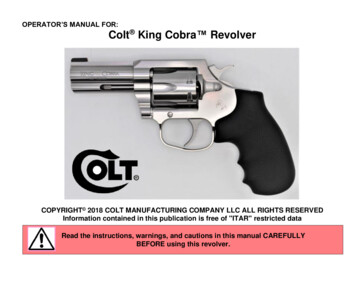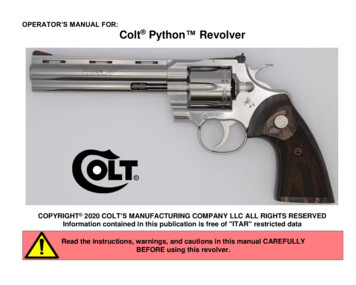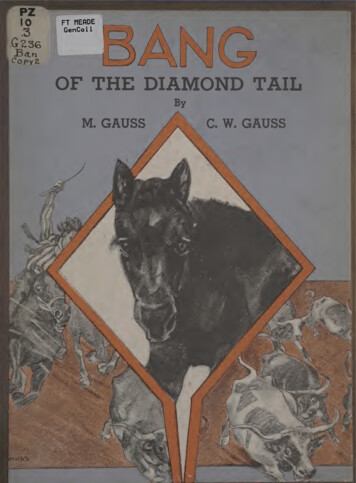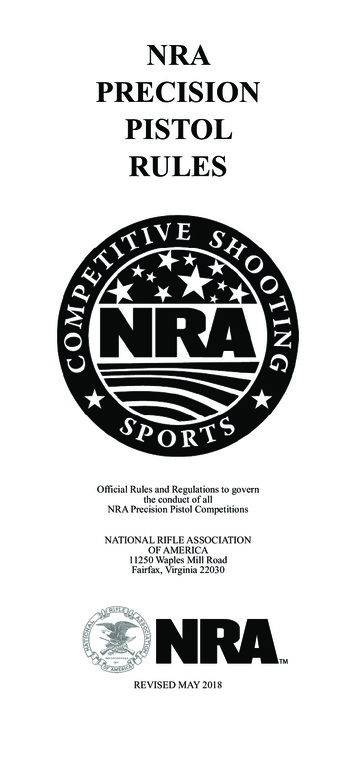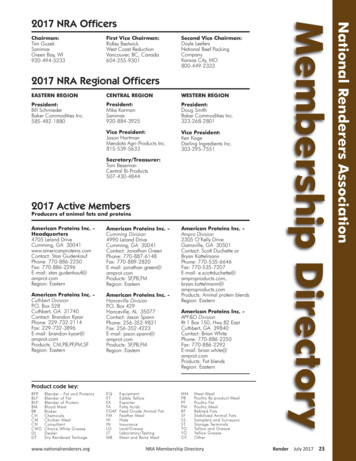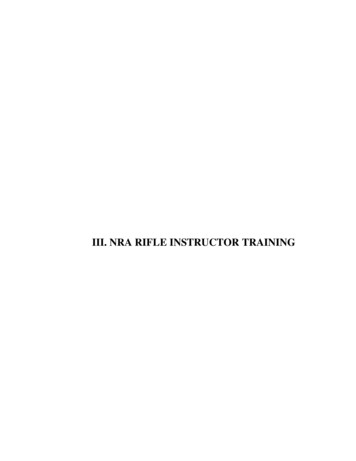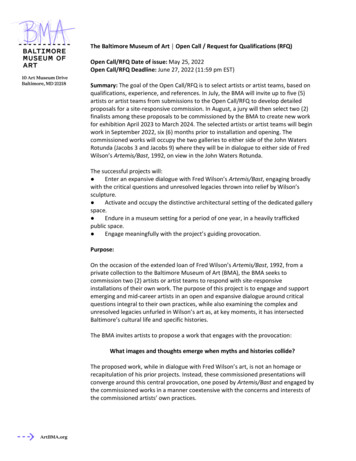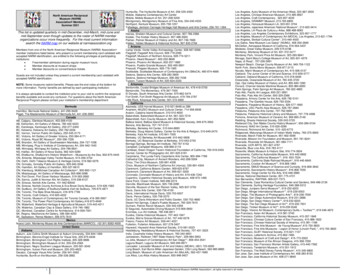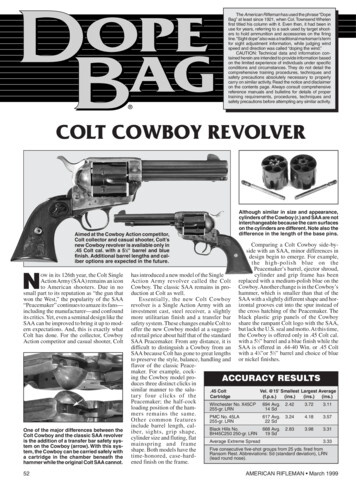
Transcription
The American Rifleman has used the phrase “DopeBag” at least since 1921, when Col. Townsend Whelenfirst titled his column with it. Even then, it had been inuse for years, referring to a sack used by target shooters to hold ammunition and accessories on the firingline.“Sight dope”also was a traditional marksman’s termfor sight adjustment information, while judging windspeed and direction was called “doping the wind.”CAUTION: Technical data and information contained herein are intended to provide information basedon the limited experience of individuals under specificconditions and circumstances. They do not detail thecomprehensive training procedures, techniques andsafety precautions absolutely necessary to properlycarry on similar activity. Read the notice and disclaimeron the contents page. Always consult comprehensivereference manuals and bulletins for details of propertraining requirements, procedures, techniques andsafety precautions before attempting any similar activity. COLT COWBOY REVOLVERAimed at the Cowboy Action competitor,Colt collector and casual shooter, Colt’snew Cowboy revolver is available only in.45 Colt cal. with a 51 2" barrel and bluefinish. Additional barrel lengths and caliber options are expected in the future.OW in its 126th year, the Colt SingleNAction Army (SAA) remains an iconto American shooters. Due in nosmall part to its reputation as “the gun thatwon the West,” the popularity of the SAA“Peacemaker” continues to amaze its fans—including the manufacturer—and confoundits critics. Yet, even a seminal design like theSAA can be improved to bring it up to modern expectations. And, this is exactly whatColt has done. For the collector, CowboyAction competitor and casual shooter, ColtOne of the major differences between theColt Cowboy and the classic SAA revolveris the addition of a transfer bar safety system on the Cowboy (arrow). With this system, the Cowboy can be carried safely witha cartridge in the chamber beneath thehammer while the original Colt SAA cannot.52Although similar in size and appearance,cylinders of the Cowboy (r.) and SAA are notinterchangeable because the cam surfaceson the cylinders are different. Note also thedifference in the length of the base pins.Comparing a Colt Cowboy side-byside with an SAA, minor differences indesign begin to emerge. For example,the high-polish blue on thePeacemaker’s barrel, ejector shroud,cylinder and grip frame has beenreplaced with a medium-polish blue on theCowboy. Another change is in the Cowboy’shammer, which is smaller than that of theSAA with a slightly different shape and horizontal grooves cut into the spur instead ofthe cross hatching of the Peacemaker. Theblack plastic grip panels of the Cowboyshare the rampant Colt logo with the SAA,but lack the U.S. seal and motto. At this time,the Cowboy is offered only in .45 Colt cal.with a 51 2" barrel and a blue finish while theSAA is offered in .44-40 Win. or .45 Coltwith a 43 4"or 51 2" barrel and choice of blueor nickel finishes.has introduced a new model of the SingleAction Army revolver called the ColtCowboy. The classic SAA remains in production at Colt as well.Essentially, the new Colt Cowboyrevolver is a Single Action Army with aninvestment cast, steel receiver, a slightlymore utilitarian finish and a transfer barsafety system. These changes enable Colt tooffer the new Cowboy model at a suggested retail price about half that of the standardSAA Peacemaker. From any distance, it isdifficult to distinguish a Cowboy from anSAA because Colt has gone to great lengthsto preserve the style, balance, handling andflavor of the classic Peacemaker. For example, cocking the Cowboy model proACCURACY RESULTSduces three distinct clicks insimilar manner to the salu.45 ColtVel. @15' Smallest Largest Averagetary four clicks of theCartridge(f.p.s.)(ins.)(ins.)(ins.)Peacemaker; the half-cockWinchester No. X45CP 694 Avg. 2.423.723.11loading position of the ham255-gr. LRN14 Sdmers remains the same.PMC No. 45LA617 Avg. 3.244.183.57Other common features255-gr. LRN22 Sdinclude barrel length, calBlack Hills No.668 Avg. 2.833.983.31iber, sights, grip shape,BH45C250 250-gr. LRN19 Sdcylinder size and fluting, flatAverage Extreme Spread3.33mainspring and fromshape. Both models have theRansom Rest. Abbreviations: Sd (standard deviation), LRNtime-honored, case-hard(lead round nose).ened finish on the frame.AMERICAN RIFLEMAN March 1999
COLT COWBOYMANUFACTURER: Colt’s Mfg. Co., Inc.(Dept. AR), P.O. Box 1868, Hartford,CT 06144, (800) 962-COLTMECHANISM TYPE: single-action revolverCALIBER: .45 ColtOVERALL LENGTH: 1015 16"BARREL LENGTH: 51 2"WEIGHT: 381 2 ozs.WIDTH: 15 8"HEIGHT: 51 8"STOCKS: two-piece, checkered, blackplastic with Colt logoCYLINDER CAPACITY: sixRIFLING: six-groove, LH twistTRIGGER: single-stage, 4-lb. pullSIGHTS: blade front, fixed square notchrear cut into topstrapACCESSORIES: foam-lined, plasticcarry caseSUGGESTED RETAIL PRICE: 600While the base pin diameter of theCowboy is identical to the SAA, theCowboy’s base pin is shorter and equippedwith a spring-loaded plunger on the tip.Also, the removable base pin bushing insidethe cylinder of First and Second Model SAArevolvers is fixed on the Cowboy.Of course, incorporation of a transfer barsafety system in the Cowboy requires a number of changes in the frame and fire controlmechanism. For example, the Cowboy hammer lacks the firing pin of the Peacemakerhammer and the hand that rotates the cylinder is different as are other small partsrequired by the transfer bar safety. Gone alsoon the Cowboy is the firing pin bushingfound on the rear face of the SAA frame.Measuring the frames of the two revolversrevealed they are approximately the samelength and height but differ slightly inwidth—the Cowboy’s topstrap measures.730" while that of the SAA is .710".While the addition of a transfer barsafety system may not seem like a bigchange, in fact, this represents a majorimprovement that cures a longstandingconcern of the SAA—carrying the gunwith the hammer down on a loaded chamber. The classic Peacemaker revolver isdangerous to carry in this conditionbecause its hammer-mounted firing pinallows energy from a blow, even accidental, to be transferred directly to the primer,possibly causing a discharge.With its transfer bar safety system, theColt Cowboy effectively prevents accidental blows to the hammer from being directly transferred to the primer. If the trigger isnot pulled, the transfer bar is not deployedand the hammer cannot reach the firing pin,which is now located in the frame. As aresult, the Cowboy is safe to carry with itscylinder fully loaded while the Peacemakeris not. Colt has integrated the transfer barsafety system into the classic SAA designwithout destroying the styling, handling oroperation. For all practical purposes, thetransfer bar safety remains transparent to theuser and observer.Many parts of the Colt Cowboy, such asthe barrel, ejector assembly, grip frame andtrigger, are interchangeable with the SAA.Parts that are not interchangeable include theframe, cylinder, hammer, fire control partsand grip panels. The Peacemaker hasremained successful in part because of its simplicity and low number of parts. With theCowboy model, Colt has tried to maintainthese characteristics by adding only the partsnecessary for the transfer bar safety system.Firing the Cowboy proved that the handling, balance and flavor of the Peacemakerhave been successfully preserved. Unlessthey counted the number of clicks whencocking the hammer, shooters could not distinguish one model from the other. ForCowboy Action competition, this will bewelcome news. Customers need not worryabout workmanship and fit of theCowboy—the example we tested wasjudged excellent on both counts.Like the Peacemaker, the sights on theColt Cowboy are calibrated for 255-gr.lead, round-nose ammunition at a catalogmuzzle velocity of 860 f.p.s. Loads withlighter bullets and/or higher velocities maynot shoot to the same point of aim. As thesights of the Cowboy are not easilyadjustable, this must be considered if theuse of such loads is anticipated.No doubt Colt has a winner in theCowboy. We look forward to it being offeredin other calibers, such as .44-40 Win., andwith other barrel lengths.The cylinder hand (arrow) on the ColtCowboy (l.) is different from that of theSAA. Note also that the new Cowboy lacksthe firing pin bushing on the recoil plate.TRADITIONS LIGHTNINGThe Traditions Lightning has features including a fluted, stainless steel barrel and removable muzzle brake that help set itapart from similar guns from other makers. Many variants of thisgun are available to suit just about any budget, need or desire.OLT-ACTION muzzleloading rifles arenow commonplace in many productlines. As this market gets ever morecrowded, manufacturers have begun toinclude options and design features that maketheir guns stand out from all the rest.Tradition’s Lightning is one such rifle. It hasmany desirable features found on other makesBAMERICAN RIFLEMAN March 1999such as a solid aluminum ramrod, interchangeable breech plugs for No. 11 percussion caps or musket caps and high-visibilityfiber-optic sights. What sets this line of riflesapart, however, is the option of a fluted, stainless steel barrel and a removable muzzle brakethe maker claims is engineered to reduce feltrecoil by as much as 40 percent.We recently received a TraditionsLightning bolt-action muzzleloader withthese two features for test and evaluation.Its barrel is 24" long, and the 41 2-oz. muzzle brake adds another 23 4" to overall length.A blued barrel with muzzle brake is alsoavailable, as well as standard-contour bluedor stainless barrels without the brake. All53
barrels are 24" with a 1:32" rate of twistrifling for stabilizing saboted or conical bullets. A slower, 1:48" twist is also availablein .54-cal. barrels.The brake consists of a cylindrical, stainless steel unit that threads onto the muzzle byhand. For those times when the brake is notused, Traditions has provided a knurled,screw-on cap to protect the threads. Thirty.17" diameter holes drilled at a right angle tothe bore around the circumference of thebrake provide ample venting of gases toeffect recoil reduction.Synthetic stocks are de rigueur on mostmuzzleloaders of this type and Tradition’sLightning is no exception. Our sample’sblack synthetic stock had molded-in checkering of 16 lines per inch on the pistol gripand fore-end, a black plastic pistol grip capand 1/2"-thick, solid, black rubber recoilpad. Quick-detachable, steel sling swivelstuds are standard, and the buttstock has amodest cheek piece. Its profile is svelte—so much so that were it not for the solid construction it would be spindly.Synthetic stocks for this model can alsobe had with a camouflage finish includingAdvantage and Break-up. For those whoprefer wood, Traditions also offers walnutfinished hardwood or laminated stocks.Like the famous ’96 Swedish Mauser, theTraditions Lightning cocks on closing thebolt. This feature adds a margin of safety inthat the striker is retracted from the nipple,yet remains uncocked for loading or priming.Stainless Lightning rifles have the bolthandle brazed onto the bolt body whilechrome-moly guns have welded-on bolthandles. As an assembly, the bolt is relatively simple. A single set screw at the rearof the cocking piece keeps the assemblytogether, and the striker is easily turned outfor cleaning using a washer or coin.The brake consists of a cylindrical, stainless steel unit that threads onto the muzzle by hand. Traditions has provided aknurled, screw-on cap to protect thethreads when the brake is not being used.Further contributing to safety is the automatic safety that is applied when the bolt isoperated. The button is on the right side ofthe action in Remington Model 700 fashionwith its position indicated by an “F” or “S”engraved in the action. When in the “safe”position, a small tab on the safety lever pivots between the trigger proper and the trigger housing to block trigger movement.Sights utilize fiber optics for increasedvisibility and are fully adjustable forwindage and elevation. The rear sight consists of a black plastic ramp and square unitfastened to the barrel with two screws. Adovetail runs the length of the top of thisramp on which rides a square, black plasticunit with integral blade. The blade is semibuckhorn with a “U” notch, augmented bySights utilize fiber optics for increased visglowing, green, fiber-optic dots on eitheribility and are adjustable for windage andside of the notch. Graduation marks on theelevation.The rear has a square plastic unitramp unit are convenient reference markswith an integral semi-buckhorn blade and“U” notch with two green fiber optic dots.for adjustment, but do not correspond withany particular amount ofchange in point of impact.ACCURACY RESULTSBoth windage and elevationadjustments are made by.50 cal.Vel. @ 15' Smallest Largest Averageloosening the respective(f.p.s.)(ins.)(ins.)(ins.)retaining screw, sliding theSpeer 300-gr. JSP1530 Avg.3.444.944.51sight in the desired direction100 grs.* Clean Shot17 Sdand re-tightening the retainCCI Musket Capsing screw to secure the sightTrad. 275-gr. PTBT1325 Avg.2.603.503.16in its new position.95 grs. Goex FFg45 SdThe front sight is also aCCI No. 11 percussion capramped, black plastic unitTrad. 265-gr. SSHPBT 1870 Avg.2.843.783.33fastened to the barrel with aThree Pyrodex Pellets41 Sdscrew, but has serrationsCCI Musket Capsacross the face of the rampAverage Extreme Spread3.66to reduce glare. A clear plasFive consecutive five-shot groups at 100 yds., fired fromtic housing dovetailed intosandbags. * by volume. Abbreviations: Sd (standard deviathe ramp retains the round,tion), JSP (jacketed soft-point), PTBT (Penetrator Tip boattail), SSHPBT (semi-spitzer hollow-point boattail)orange, fiber-optic frontsight element.54TRADITIONSMANUFACTURER: Traditions (Dept. AR),P.O. Box 776, Old Saybrook, CT 06475,(860) 388-4656CALIBER: .50 (tested), .54ACTION TYPE: cock-on-closing, boltaction, percussion-fired muzzleloaderRECEIVER: stainless steel (tested),chrome molyFINISH: natural satin stainless steel(tested), gloss blueOVERALL LENGTH: 421 2" (without) brakeBARREL: 24", heavy contour, flutedstainless steel with muzzle brake (tested) or without; 24", heavy contourblued with or without muzzle brakeRIFLING: conventional, eight-groove, button (blued), cut (stainless), 1:32" RHtwist (tested), 1:48" (.54-cal.) RH twistWEIGHT: 8 lbs.SIGHTS: fully adjustable, semi-buckhornrear with “U” notch and green fiberoptic dots; ramped front with orangefiber-optic elementTRIGGER: adjustable, single-stage,41 4-lb. pullSTOCK: walnut-stained select hardwood, brown laminate (no checkering),synthetic black or camouflage: lengthof pull, 14"; drop at heel, 13 4"; drop atcomb, 11 2"ACCESSORIES: musket cap nipple, No.11 percussion cap nipple, take-downtools, muzzle cap (rifles with muzzlebrake only)SUGGESTED RETAIL PRICE: 219- 376Since scopes are used more often thannot on a muzzleloader of this type, the actionis drilled and tapped for Remington Model788 bases. We used mounts and rings fromS&K to hold a Tasco 3-9x40 mm scope andfired the Traditions Lightning for accuracyat 100 yds. Only saboted bullets were usedto take full advantage of the fast rate of twist,and we used loads that included PyrodexPellets, Goex blackpowder and Clean Shotblackpowder replacement. The results ofthis testing are summarized in the accompanying table.Our testing also corresponded with theopening of Virginia’s muzzleloader season,so we took the Traditions Lightning deerhunting. Long guns like the TraditionsLightning are often carried afield cradled inthe crook of the arm. The hunt revealed thatThe bolt is a relatively simple assembly. Asingle set screw in the cocking piece keepsthe assembly together. After its removal,the gun’s striker is easily turned out fromthe front using a washer or coin as a tool.AMERICAN RIFLEMAN March 1999
Further contributing to safety is the automatic safety that is applied when the bolt isoperated. The safety button is fashionedafter the Remington Model 700,with its position indicated by an engraved “F” or “S”.(about 46 percent) without the brakeinstalled. A very positive aspect of the muzzle brake, however, is that it serves the samefunction as a false muzzle in that it helps lineup the bullet for straight starting into themuzzle. Velocity was also different whenusing the muzzle brake. When shootingClean Shot powder, velocities with the brakewere about 30 f.p.s. faster. Conversely, whenusing the brake with the blackpowder loads,velocities averaged 56 f.p.s. slower.The bolt handle is well-positioned,being easy to grasp, but not so far out asto interfere with the scope. We would haveliked to see more attention given to attaching the bolt, though, as there was a notice-carrying the gun as such gradually pushes thebolt handle up. If not checked regularly, thebolt handle will reach a point where it popsup and jumps back, making a lot of noise.Our test shooting revealed a number ofstrong points in favor of this rifle, as well assome that need more consideration. The fluted barrel does a good job of keeping the overall weight of the gun to a manageable levelwhile increasing barrel stiffness. Stock proportions make this gun very pointable, andthe recoil pad absorbs much of the recoil.The muzzle brake did seem to reduce feltrecoil, though 40 percent may be a stretch.The holes in the brake make loading loosepowder troublesome but not impossible, andthe gun was considerably more accurateThe Lightning employs a “switch nipple”system, so the gun can use either No. 11caps or musket caps. We tried both in ourtest and found velocity with musket capswas up to 50 f.p.s. lower than with No. 11s.able gap on three sides of the root in whichfouling will become trapped.The knurled cap is a nice feature to dressup and protect the muzzle when the brake isnot attached, but the brake was taken intoconsideration when sizing the ramrod,which protrudes 2" past the muzzle whenthe brake is removed. We’d rather have aramrod too long than too short, butTraditions offers a rod of the appropriatelength should a Lightning owner decide toomit the brake.Musket caps are not as readily availableas standard No. 11 percussion caps, so theinclusion of both No. 11 and musket cap nipples with the gun was welcome. While wechose to use the musket cap nipple for mostof our shooting, we used the No. 11 capswith blackpowder to make sure the “switchnipple” system worked, which it did. Wealso tested whether there was any notableballistic difference in using musket caps orpercussion caps with the same load.Surprisingly, velocity with musket caps wasas much as 50 f.p.s. less than the identicalload ignited by No. 11 percussion caps.Traditions’ Lightning bolt-action muzzleloader is available in 12 variations to suitjust about any budget, need or desire. Thegun we tested was rugged, accurate andwell-made for the most part. Shooters looking for contemporary styling in a blackpowder rifle will want to add the Lightningto their list of candidates.MERKEL 2001ELMerkel brought modern CNC and EDM machinery on line in 1998 to augment theskills of its craftsmen. A sample of the mixture of traditional and new technology was recentlyreceived in the form of a Model 2001EL—a box-lock, over-under shotgun that retains Merkel’s distinctive appearance.OR decades, Merkel’s catalogs proudly stated that its shotgun actions weremade the same as they were in the1920s. That changed in 1998 when Merkelbrought modern CNC and EDM machineryon line to augment the skills of its craftsmenthat have evolved through generations ofmaking exceptional side-by-sides, overunders and combination guns.A sample of this mixture of traditionaland new technologies was recently receivedin the form of a Model 2001EL—a modified Anson & Deeley-type box-lock, overunder shotgun with a Kersten crossbolt thatretains Merkel’s distinctive outside appear-FAMERICAN RIFLEMAN March 1999ance. Externally, there is no evidence to suggest that hand fitting and finishing have beenabandoned for the sake of modernization.Three grades are offered: the minimally engraved standard 2000EL; the heavilyengraved mid-range 2001EL (tested); andthe high-grade 2002EL with fullyengraved false sideplates. Our sample2001EL was stocked with dark, nicely figured walnut, hand-checkered in a doublebordered point pattern of 24 lines per inchon the pistol grip and fore-end. We notedseveral overruns covered by the border,places where the checkering came up shortand some flat points. The fore-end is theWood-to-metal fit on our sample wasexcellent—a testament to the inletting skillof the stockmaker considering the difficulty of mating the action to the buttstock.55
traditional Suhl, three-piece style, the bottom of which is secured by a Deeley-typelatch and covers only part of the bottombarrel. Two top side panels are attachedthrough the side ribs with three engravedscrews. The seam between the panels andthe bottom wood is hardly noticeable andnicely obscured with parallel lines. A careful examination of the three parts suggeststhat they were not cut from the same pieceof wood, though the difference betweenthem is barely perceptible. As a whole, thefore-end provides plenty of room forlarge-handed shooters, while retaining asvelte profile.Wood-to-metal fit on our sample wasexcellent—a testament to the inletting skillof the stockmaker when considering the difficult radiuses and points where the actionmates with the buttstock. Both the grip plateand the butt plate are black plastic with nohangovers or gaps.Lockup remains the Kersten crossboltsystem, which is a modification of theGreener crossbolt lock. Square lugs withcentrally located round holes extend backfrom the top of the over barrel into corresponding cuts in the gun’s standing breech.MERKEL 2001ELMANUFACTURER: Suhler Jagd-undSportwaffen Gmbh, SchutzenstraBe 26,Postfach 130, 98527 Suhl, GermanyIMPORTER: GSI, Inc. (Dept. AR), P.O.Box 129, 108 Morrow Ave., Trussville,AL 35173, (205) 655-8299GAUGE: 12 (tested), 20, 28CHAMBER LENGTH: 3" (28-ga. 23 4")ACTION TYPE: Modified Anson &Deeley box-lock over-underRECEIVER: satin grayed steelOVERALL LENGTH: 443 4"WEIGHT: 7 lbs.BARREL: 12-ga., 28" (tested), 30";20- and 28-ga., 263 4"CHOKE SYSTEM: fixed, full/modified,modified/improved cylinder, others onrequestFINISH: high-polish blued barrels, silvergray actionTRIGGER: mechanical, single, selective,31 2--lb. pull over barrel, 31 4-lb. pull underbarrelSTOCK: satin oil-finished luxus gradewalnut: length of pull, 141 8"; drop atheel, 21 2"; drop at comb, 11 2"ACCESSORIES: trigger length of pulladjustment wrenchSUGGESTED RETAIL PRICE: 2000EL, 5195; 2001EL, 6495; 2002EL, 999556In-house engraversMERKEL 2001ELare the pride of Merkeland our sample ModelAVERAGE OF 10 PATTERNS AT 40 YDS.2001EL demonstrateswhy. Both sides of the16202021silver-grayed receiverare attractively en38422628graved with gamescenes while its bottomis scroll-engraved in a25282728pattern that borders theentire action and covers11101716the bolsters. All screwheads are engraved andtastefully timed.Full ChokeModified ChokeBlued barrels arex Point of Holdjoined by the demiFederal Premium Magnum 2 "-1 oz.-No. 6 leadblock system in whichAverage Pellet count—253each cold-hammerMeasured Velocity @3-ft.—1389 f.p.s.forged barrel has aRemaining energy per pellet @40 yds.—3.04 ft.-lbs.solid, forged breechsection. The breechTotal Hits190 (75%)Total Hits173 (68%)section of the over bar21.2" Inner Circle 133 (53%)21.2" Inner Circle 109 (43%)rel is shaped like an30" Outer Ring57 (22%)30" Outer Ring74 (29%)inverted U, with thelower barrel mechanically fitting into a squared recess in its bot- ly disables the sears to convert the Modeltom. Ostensibly, this arrangement makes it 2001EL from ejectors to extractors.Past Merkel over-unders used the “Blitz”possible to locate the barrels more positively before they are finally soldered together. box-lock action that had most of its partsSide and top ribs are solid, though the top is mounted on the trigger plate. Removal wasgrooved to reduce glare and has a single, tricky at best and revealed a collection of tinybrass front bead. A ventilated rib is option- screws, leaf springs and oddly shaped parts.al, though there may be an additional charge. With capitalism came the need to produceshotguns more economically. While CNCand EDM machinery made it easier and lessexpensive to produce precise parts, the greatest savings realized came with the switch toa modified Anson & Deeley box-lock action.This much-simplified system uses coilsprings instead of leaf springs. Hammers,sears and cocking levers fit in slots in theframe and are pivoted on pins or screwsrather than being attached to the triggerSmall slotted screws are incorporated intoplate. Cocking indicators found on otherthe fore-end iron to disable the ejectorMerkel shotguns have also been eliminatedsears. Rotating the screws 90 degrees confrom this model.verts the automatic ejectors to extractors.Traditional double triggers are cataLockup remains the Kersten crossbolt loged, but our sample came with a single,system, which is a modification of the selective, mechanical trigger. To selectGreener crossbolt lock, and is well-known which barrel to fire first, Merkel has profor its strength. Square lugs with centrally vided a new lever housed in the split in thelocated round holes extend back from the rear of the triggerguard. This is a noticeabletop of the over barrel into corresponding change from the bar parallel with the trigcuts in the standing breech. A thick cross- ger often found on Merkel shotguns. Thebolt in the left side of the receiver passes new selector seemed a lot less obtrusive tothrough the holes to lock the action. Thoughlumps are apparent on the bottom of theblock, they are not part of the lockup.An interesting new feature is found at theejectors. When a barrel is fired, its respectivetrip rod bears against a sear in the fore-end.The sear holds the ejector until the barrels arelowered, then releases the ejector to throw theshell. This is little changed from the earlier The Merkel 2001EL’s fore-end is the tradiMerkel design. New, however, are small slot- tional Suhl three-piece style, the bottom ofted screws incorporated into the fore-end which is secured by a Deely-type latch andsears. Turning these screws 90 degrees part- covers only part of the gun’s bottom barrel.3418-AMERICAN RIFLEMAN March 1999
us, and was easy to use. Pivoting it to theright selects the under barrel to fire first.Another nice feature is the trigger that isadjustable for length of pull over a 1/4"range. While 1/4" is insufficient to adjust thefit between a small-framed female and aburly football player, it is enough to providethat “just right” fit for the average-sizedshooter. Adjustment is by turning out completely the small Allen head screw from theface of the trigger blade using the suppliedwrench, repositioning the trigger over one ofthree screw holes, then replacing the screw.Barrel joining is by the demi-block systemin which each has a solid, forged breechsection.The over barrel’s breech is shapedlike an inverted U, with the lower barrel fitting into a squared recess in its bottom.The trigger is used to adjust length of pullover a range of 1/4". Using an Allen wrench,turn out the retaining screw, reposition thetrigger over one of the three screw holes,and turn the screw into the respective hole.A manual safety is in the top tang.Pressing the button forward allows the gunto be fired, while pressing it rearward exposes the letter “S” and locks the trigger.The Merkel 2001EL was patterned at 40yds. with 11 8 oz. No. 6 Federal PremiumMagnum shotshells. The results are summarized in the accompanying table. Oursample had a fixed full choke in the overbarrel while the under barrel was chokedmodified. Patterning was unusually tight,though we experienced the same result withMerkels that have been previously testedhere. Modified and improved cylinderchokes are also available, and other chokescan be had by special request, so a prospective buyer may want to consider a more openchoke than they’re used to.Use of the Kersten crossbolt results inan action with extra width and height.Despite the additional metal, the Merkel2001EL is a lively gun and well-balanced.Many who handled the test sampleremarked how easily it came to the shoulder and how well it pointed.An unusual observation with respect tothe mechanical trigger was noted whiletesting the gun. If the crossbolt did notfully seat, the second sear would notalways trip. Nor would it trip if the gunwas fired nearly straight up as encounteredin some Sporting Clays stations. Neitherproblem occurs if the top lever is manually indexed to the left with slight pressureto ensure the crossbolt is fully seated whenthe action is closed. This information isdetailed in the owner’s manual, thoughindexing should not be necessary once thecrossbolt wears in.Merkel, then, has stuck its toe in thewaters of modern manufacturing withoutabandoning the skill and craftsmanship thatmade it famous. As an example of Merkel’sprogress, the Model 2001EL exhibits excellent handling qualities, with aestheticallypleasing style and detail.ROCK RIVER BULLSEYE WCSince most bullseye competitors preferoptical sights, the Rock River BullseyeWadcutter comes equipped with a Clarkrail mount on the slide and no metal sights.Rock River Arms’ new, M1911-A1, BullseyeWadcutter match pistol incorporates numerousadvanced technical features with a high order of fit and finish.Out of the box,this pistol is capable of firing possible scoresin every appropriate stage of National Match competition.OCK R IVER A RMS ’new Bullseye Wadcutter target pistol isnot just another M1911A1 clone. Rather, itis a specialized target pistol combiningnumerous and proven, tec
Colt Cowboy and the classic SAA revolver is the addition of a transfer bar safety sys-tem on the Cowboy (arrow).With this sys-tem,the Cowboy can be carried safely with a cartridge in the chamber beneath the hammer while the original Colt SAA cannot. 52 AMERICAN RIFLEMAN March 1999 Aimed at the Cowboy Action competitor,
